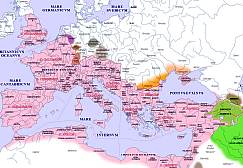

An Online Encyclopedia of Roman Emperors
Marcellus (366 A.D.)
Thomas Banchich
Canisius College
Ammianus Marcellinus and Zosimus give complementary versions of the role of Marcellus 5 (PLRE I, p. 551) in revolt of Procopius and of Marcellus' elevation in its immediate aftermath. Zosimus (4.6.3-5), following Eunapius, has Procopius send Marcellus from Constantinople to Bithynia to attack cavalry units detailed there under the command of Serenianus. Serenianus occupied Cyzicus, but Marcellus took the city and had Serenianus, who had escaped and fled to Lydia, hunted down and killed. After Procopius' defeat at Nacolia and execution (27 May 366), the victorious Valens captured Marcellus and, enraged at the discovery of imperial regalia passed to Marcellus by Procopius, liquidated him along with his followers, friends, relatives, and any suspected of withholding information (4.8.3-5). Likewise, John of Antioch (frg.184.2 [FHGIV, p. 608]) briefly notes that Valens slaughtered Marcellus and many others on the ground of suspicion of lese majeste.
Ammianus (26.10.1-5), who gives Marcellus the rank of protector and notes the important factor of his kinship with Procopius, puts Marcellus in command of the garrison of Nicaea at the time of Procopius' defeat and death. Upon learning of these events, Marcellus executed Serenianus, imprisoned at Nicaea after his capture by Procopius' forces at Cyzicus, where he had been guarding moneys moved there by Valens for distribution to the troops of Asia Minor (26.8.6-11). Unlike Zosimus, Ammianus does not mention Marcellus in connection with the taking of Cyzicus.
Marcellus next gained control of Chalcedon. There, with the encouragement of but a few backers, Ammianus says, "he seized the shadow of a fatal principate (umbram principatus funesti capessit). According to Ammianus, two factors motivated this usurpation: Marcellus' belief in his ability to purchase the continued support of Procopius' Gothic allies for a representative of the Neo-Flavian Dynasty, and his ignorance of events in Illyricum, by which Ammianus presumably means the investment of Philippopolis by an army under Valens' Magister Militum per Illyricum Equitius. This Equitius, when informed of Procopius' defeat and death, moved aggressively against Marcellus, whom he captured and imprisoned. Several days later, Marcellus, together with some of his accomplices, was scourged and executed.
Paschoud, Francois. Zosime: Histoire Nouvelle. Paris: Societe d'Edition Les Belles Lettres, 1979. Volume II.2, pp. 344-345, n. 118, and 349, n. 122.
Jones, A.H.M. J.R. Martindale, and J. Morris. "Marcellus 5" the Prosopography of the Later Roman Empire, (Cambridge, 1971), 1.551.
Comments to: Thomas Banchich
Updated: 18 August 1996
For more detailed geographical information, please use the DIR/ORBAntique and Medieval Atlas below. Click on the appropriate part of the map below to access large area maps.
